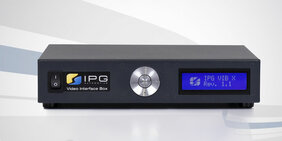Conventional environments for tests of camera-based assistance systems reach their limits when the latest generations of cameras are involved. Filming a recorded or a synthetically generated scenario off a monitor, for instance, entails a high potential for error. From dim and weakly contrasting monitors, only insufficient input data for light assistance functions can be generated, for example, or wrong reactions of the algorithms are provoked due to a lack of image synchronization.
Since 2014, IPG Automotive has offered the Video Interface Box as a successful solution allowing these and other sources of errors to be avoided thanks to imager emulation and direct image injection into the camera, which yields valid test results. The first generation of the product already enabled the simultaneous emulation of up to four cameras, making it optimally suited for testing multi-lens systems such as stereo cameras or bird’s-eye view systems.
With the new Video Interface Box X, IPG Automotive has now increased both functionality and flexibility. Via a newly created C code API, all implemented emulations can now be accessed from one box and employed for generic use. In addition, a new Ethernet interface enables remote access of the emulations. All channels are synchronized, while resolutions and frame rates remain independently configurable. Thanks to the new C code interface, users can now also run their own imager emulations or configurations and optimally adjust the test environment to their individual needs. “The Video Interface Box X now makes our customers even more successful in minimizing their test effort for camera-based systems, implementing projects faster and reducing their costs in this way. They have access to a tool that allows for flexible use and even faster integration into the test process than its predecessor,” summarizes Raphael Pfeffer, Product Manager Test Systems at IPG Automotive.
